How Boeing Was Set on the Path to Disaster by the Cult of Jack Welch

- Oops!Something went wrong.Please try again later.
- Oops!Something went wrong.Please try again later.
- Oops!Something went wrong.Please try again later.
On April 20 this year, a group of the largest stakeholders in Boeing took part in a virtual version of the company’s annual general meeting. A few hours before the meeting opened online, they learned something that took them by surprise: The retirement age for the top job, CEO of the aerospace colossus, was suddenly being raised from 65 to 70.
This meant that the current CEO, Dave Calhoun, who was 64, could enjoy at least another five years in the job. A move like that would normally indicate that the stakeholders were so pleased with the way a company was being run that they thought the best way of keeping it that way was to leave the boss in place rather than replace him.
But this was Boeing, and the company had never been in worse shape. Calhoun had been in charge since January 2020. In that time, its previously stellar reputation for engineering excellence had been publicly shredded after two crashes of its newest jet, the 737MAX, had killed 346 people, because of serious failures in Boeing’s safety regimen. At the same time, other airplane programs, both commercial and military, were plagued with problems, and its effort to catch up with Elon Musk’s SpaceX program supplying astronaut-carrying capsules to NASA suffered repeated and ignominious failures.
If any of the stakeholders were puzzled why they were expected to fall into line and approve Calhoun’s extended tenure, they didn’t reveal it. They, and the company’s board of directors, swiftly ratified the deal. In fact, the relative serenity of Calhoun’s ascendancy (which, given the haste of the deal, had the hallmarks of a coup) indicates something larger than just how passive Boeing’s board and main stakeholders are: It’s a reflection of how far in America personal greed has superseded the old standards of corporate governance and eradicated any sense of personal accountability for a catastrophic management record.
More seriously, the Boeing case seems to show how easy it has become to insulate senior executives from the consequences of actions that lead not only to the horrendous deaths of hundreds of people but to the lifelong anguish and suffering of the victims’ families. Inevitably, airplane crash investigations disappear down numerous rabbit holes of technical obscurity; more often than not culpability is a collective, not individual act and has so many fingerprints that the simple villainy of homicide is impossible to ascertain.
All this generates in the public an impotent anger. Why are there no penalties to pay? A congressional committee delivered a withering bipartisan indictment of Boeing’s leadership. There have been damning TV documentaries and a series of granular newspaper investigations, to little effect. And now there is Flying Blind, by Peter Robison, a reporter for Bloomberg, that is published tomorrow. Much of the forensic detail is familiar, but the picture it provides of Boeing’s management and its ethical vacancy piles on another layer of disgust.
THE PROGENY OF ‘NEUTRON JACK’
Every attempt to divine how Boeing’s culture went from exemplary to execrable tends to lead to a man who never laid his hands on Boeing, Jack Welch, the infamously bottom-line hatchet man, known as “Neutron Jack” for his ability to vaporize thousands of jobs at General Electric while its CEO from 1981 to 2001 before leaving with a $417 million exit payment. His leadership style, once hailed as a master class in squeezing as much money as possible out of any business, became posthumously toxic. Nonetheless, managers schooled by Welch fanned out to work their magic at other companies deemed in need of it.
Robison tracks in great detail how this influence shaped Boeing—all the way to Calhoun. It begins with Harry Stonecipher, who reached Boeing via one of Boeing’s main competitors, McDonnell Douglas. In 1997, in one of the largest mergers in the aerospace industry, Boeing took over McDonnell Douglas. But, in terms of the cultural consequences, the reverse happened. The chairman and CEO of Boeing was Phil Condit, a talented engineer who had risen to the top through many layers. This was a characteristic Boeing career path, one that I explored in reporting for my book Wide Body, the story of the men who created the legendary Boeing 747 (during which I met Condit). Condit belonged to a cohort known as the aeromen, engineers who had Boeing’s pioneering brilliance in their blood and imprinted it on the whole company—unlike McDonnell Douglas, a company once renowned for its jets that, under more bottom-line driven managers, had lost its luster.

Harry Stonecipher speaks at a press conference following Boeing's annual meeting in 2004.
It turned out, however, that Condit became tantalized by the perks of power and particularly by men who got rich by being hard-nosed managers. Stonecipher, who acquired a large chunk of Boeing stock in the merger, impressed Condit as a role model for a change in management style and he gave Stonecipher, as chief operating officer, the green light to set about injecting the Welch bacillus into Boeing, which he did with a relentless drive to cut costs. He ripped into senior managers, charging that they were “hobbyists who didn’t know how to run a business.” The combination of the two men did get results: Boeing’s annual revenue jumped from $23 billion to $54 billion in seven years.
Unlike Stonecipher, Condit remained popular among Boeing’s engineers and in the production plants. But many were dismayed in 2001 when he moved Boeing’s corporate headquarters from Seattle to Chicago. For sure, the company was now an aerospace giant, with plants widely dispersed across the U.S. But the move was sacrilege to the aeromen. Seattle was in the company’s DNA. Its many historic achievements had been nurtured there. Microsoft and Amazon, both created there, remained happily ensconced. But Boeing’s top brass, it seemed, were leaving the company’s history behind them because to them it seemed too provincial.

Phil Condit addresses the media following Boeing’s annual shareholders meeting in 2003.
In 2003, Condit resigned, taking responsibility for a scandal involving Pentagon contracts, although he was not personally involved, and Stonecipher became CEO, only to be fired in 2005 when it turned out that he had been having an affair with an executive in the company’s Washington lobbying team. That did not, however, break the Welch chain. Stonecipher was replaced by another Welch protégé, Jim McNerney, who received, on signing, a pay package worth $52 million and who, every bit as ruthlessly as Stonecipher, thought it a priority to build Boeing into a money-making machine loved by Wall Street rather than perpetuate a culture that had always balanced profits with sustaining Boeing’s hard-earned status as a world leader in the quality of its engineering.
And it was McNerney who, in 2011, took the decision that would eventually tank Boeing. The most lucrative airplanes for Boeing and Airbus are the single-aisle jets, the world’s workhorses. Boeing’s decades-long cash cow, the 737, was rapidly losing market share to Airbus’ far more modern A320 series. Boeing’s best brains had known that this would eventually happen. They thought that the 737 series had reached the natural end of its life cycle and advocated a clean-sheet replacement, a jet that would have rendered the A320 obsolete.
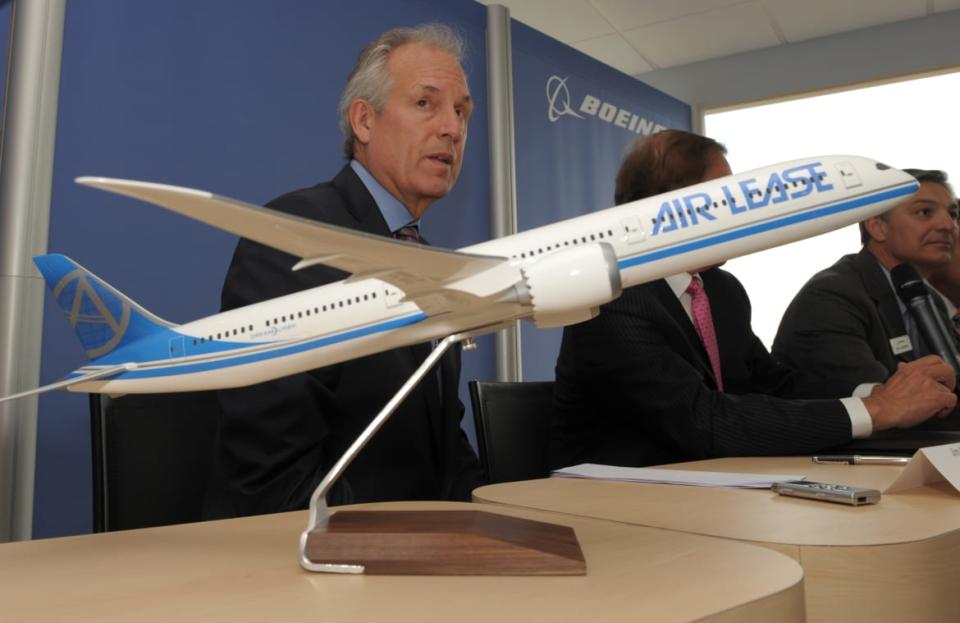
Jim McNerney attends a signing ceremony with Air Lease Corporation for the 787-10 Dreamliner.
At the time, I spoke to an old friend, Joe Sutter, mastermind of the team that created the 747, mentor to many younger engineers, and regarded as the definitive custodian of the Boeing legacy. He had a unique take on the 737 because he was the only survivor of the team that created it in the 1960s. In fact, he was responsible for a crucial decision that made the design open to evolving into ever-larger models.
The 737 was the company’s response to a competitor that was rapidly dominating the single-aisle market, the Douglas DC-9. Sutter thought that Douglas had made a serious mistake by placing their jet’s engines at the tail, which, for reasons of balance, made it difficult to lengthen the cabin. The 737’s lead designer was about to do the same, but Sutter persuaded him to put the engines on the wing, a decision that Sutter claimed, with good reason, was to make a fortune for Boeing. But now Sutter told me that he agreed with the engineers who believed that the 737 design was at the end of its realistic life. He didn’t enjoy flying on it himself because the cabin was narrower than the A320, making the seating more cramped. The new engine in prospect for the replacement model deserved a new state-of-the-art airplane that could be another world-beater for Boeing and that was what he was recommending. But McNerney, touting the Welch philosophy of “more for less,” ruled out the new jet and opted, instead, for what became the 737MAX, a hybrid of yet another iteration of the old airframe and the vastly improved engine that would give airlines much higher efficiency. The new program would cost $2.5 billion; the clean-sheet jet would have cost $20 billion. (As it turned out, the MAX catastrophe has cost the company well north of $20 billion.)
It appeared that the Welch chain had finally ended when McNerney retired in 2014 with a package of $58.5 million. He was replaced by the son of an Iowa farmer, Denis Muilenburg, whose whole career had been with Boeing. But McNerney had carefully indoctrinated his successor with the Welch doctrine—specifically ruling out what he called “moonshot” gambles on the scale of those that had produced every generation of Boeing’s legendary jets.
Muilenburg hadn’t been a particularly accomplished executive: He was part of a team competing for a Pentagon fighter contract that lost out to Lockheed Martin, and he was involved in another weapons program that was canceled. But he knew how to turn the screws to cut costs and made that a personal priority. At the same time, Muilenburg followed McNerney’s mission of turning the company into an ATM machine for its stockholders. Between 2013 and 2018 Boeing funneled $41.5 billion in stock buybacks to them (and the directors). Under Muilenburg, the stock price tripled. During those years the most influential backer of this policy on Boeing’s board was Dave Calhoun—another Jack Welch acolyte.
BLAME THE PILOTS
In the days following the first MAX crash, of Indonesian airline Lion Air Flight 610 on Oct 29, 2018, killing 189 people, Boeing swiftly settled on their line of defense: The pilots were to blame. In my reporting for the Daily Beast, I pushed back on this, but Boeing doubled down, insisting to me in a long briefing by several senior executives that the pilots could have regained control had they followed “a memory item” in the flight manual— in other words, they should have remembered a procedure used on earlier models to deal with rogue movements of the stabilizer. As it turned out, that would not have saved them. It was obvious that this line was coming directly from Muilenburg. It was preposterous, since the flight manual made no mention that the MAX had a new autonomous control system that was, in fact, responsible for both this and the second crash, of Ethiopian Airlines Flight 302 on March 10, 2019, killing 157 people.
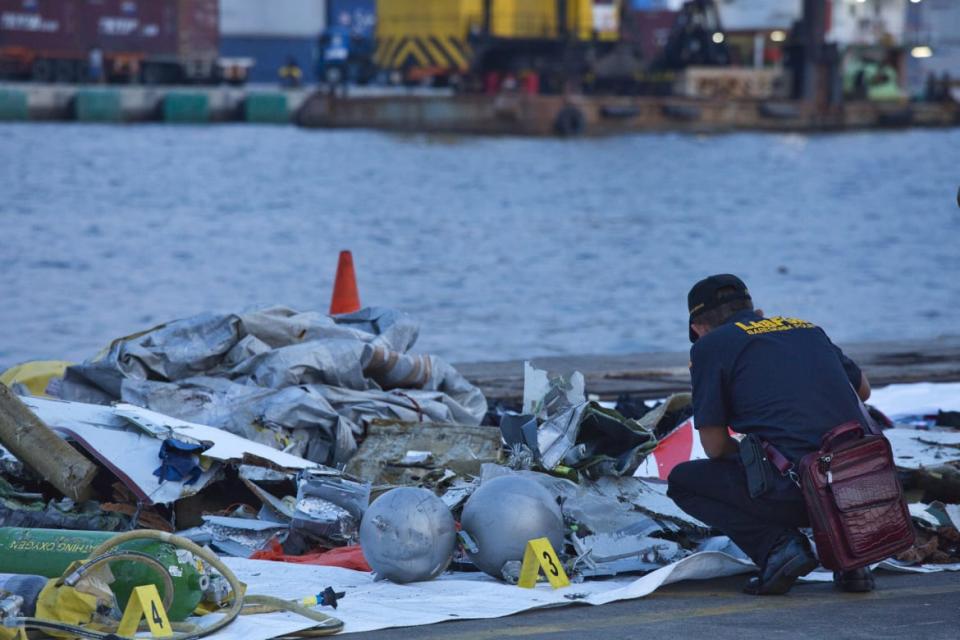
A forensic investigator looks through the remains of Lion Air flight 610 at the Tanjung Priok port in Jakarta, Indonesia.
Boeing’s readiness to blame the pilots persisted and was one of the things that most exasperated investigators, particularly the U.S. House Committee that reported in September 2020 that the crashes were the “horrific” result of flawed technical assumptions and a lack of transparency from the company’s leadership. In his evidence to the lawmakers, one of the most respected pilots in the world, Captain Chesley “Sully” Sullenberger, said the chain of errors “began with decisions that had been made years before to update a half-century-old design…we owe it to everyone who flies to do much better than to design aircraft with inherent flaws that we intend pilots to have to compensate for and overcome.” The committee pointed to how Muilenburg had pressured engineers to meet unrealistic deadlines. But Muilenburg pushed back, saying that the pressures existed but “never interfered with safety.”
Muilenburg’s stonewalling did not play well with lawmakers or the public and, in December 2019, he was fired by the board. Although he forfeited bonuses, his exit package was worth at least $62 million. He was replaced by Calhoun. At first, the company said it was a temporary arrangement while they hunted for a longer-term replacement from inside the aerospace industry, not a finance man. Soon, though, it was apparent that Calhoun had taken to the task. He had, throughout, backed Muilenburg’s hard line on the pilots and, astonishingly, appeared reluctant to retreat from it, even while the lawmakers were putting together their damning indictment of Muilenburg’s leadership. He came up with a subtle but insidious new version of shifting the blame in an interview with Aviation Week. He said that if Boeing had learned anything from the crashes it was the need to better understand the “man-machine interface.” This involved “pilot populations and different training. We know the pilot population has changed. We know where we’re selling airplanes and how young the compliance systems are in some of those markets.”
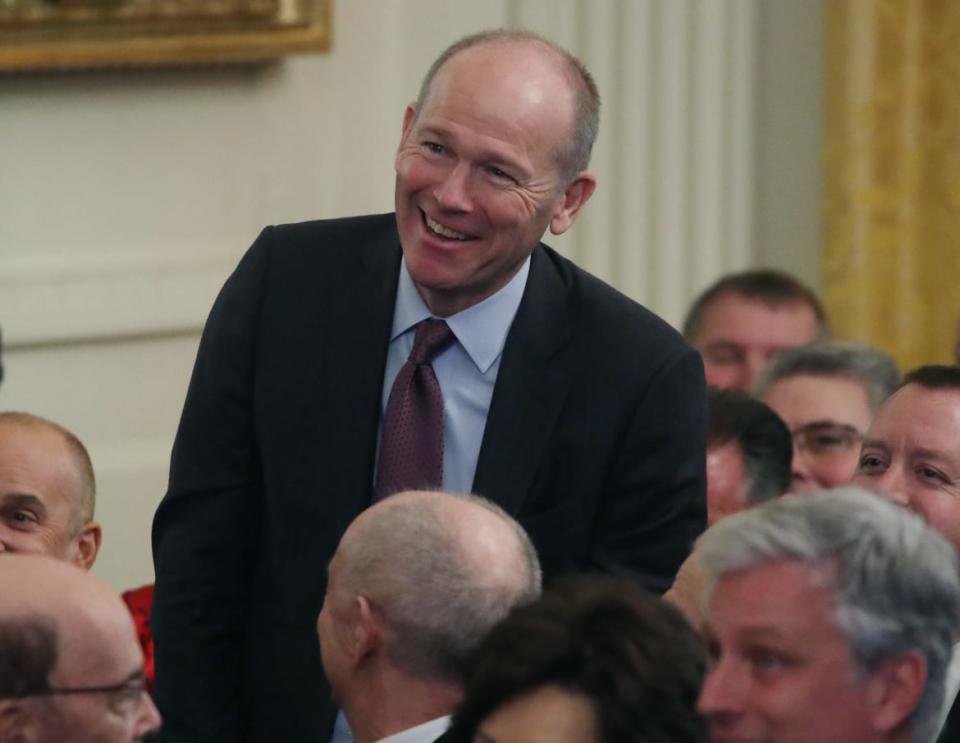
Boeing CEO David Calhoun is introduced shortly before President Donald Trump and Chinese Vice Premier Liu He signed phase 1 of a trade deal between the U.S. and China, in the East Room at the White House, on Jan. 15, 2020.
In other words, Calhoun was suggesting a cultural problem rather than a technical one. He implied that pilot proficiency was variable and, by inference, that Indonesian and Ethiopian flight crews were from parts of the world where training was “different.” Apart from gratuitously insulting the dead pilots (whose proficiency was never questioned), he was again shifting responsibility away from Boeing to regional regulatory systems—all of whom have to meet a global standard set by the International Civil Aviation Organization.
The congressional investigators were crystal clear on this issue: “To make the claim that these accidents would not happen to U.S. trained pilots is presumptuous and not supported by fact. Vilifying non-U.S. pilots is disrespectful and not solution based… Boeing does not produce aircraft for U.S. pilots vs. pilots from the rest of the world.”
Pilot proficiency does vary, but not according to what language the pilots speak. It varies by age, experience, and sometimes the mood of the moment. Pilots are human. Decades have been spent equipping cockpits with constantly improving aids that eliminate the chance of pilot error—with spectacular results in safety. The MAX was, in the words of Sully Sullenberger, a death trap because Boeing made it so. Calhoun, apparently just can’t go there.
ANOTHER ‘UNCOMMANDED PITCH EVENT’
Under Calhoun, the Boeing sickness is not in remission—far from it. Its next major airliner program is another iteration of an existing design, the widebody 777. With the disappearance from airline fleets of the two jumbo jets, the 747 and the Airbus A380, the upgraded 777 will be the largest jet in service. It made its first flight in January 2020, but 11 months later a serious problem showed up in a test flight—and, incredibly, it involved the same alarming event that was fatal to the 737MAX: an “un-commanded pitch”—meaning that the jet’s nose pitched upward without any action by the pilots.
This was disclosed in a letter sent by the FAA to Boeing in May, first reported by the Seattle Times. For decades the FAA had been far too lax in its oversight of Boeing. Now the regulator had finally found its cojones. The tone of the letter was unusually admonitory. Boeing had requested permission to begin the next phase of testing that would lead to the FAA certifying that the jet was ready to be delivered to airlines. Refusing that request, the FAA warned that “The technical data required for type certification has not reached a point where it appears the aircraft type design is mature and can be expected to meet the applicable regulations.” Including the un-commanded pitch, there were 11 issues that needed to be resolved. Moreover, the FAA said Boeing had failed to provide an overall safety assessment of the design, as required—a lapse that had also occurred when the MAX was in development. In short, Boeing had not corrected systemic behavior that was again potentially endangering the safety of an airplane. (The chief engineer of this program was a lead engineer on the 737MAX.)
The 777 flaw was buried deep in software, reflecting a recurring source of trouble in both commercial and military programs at Boeing.
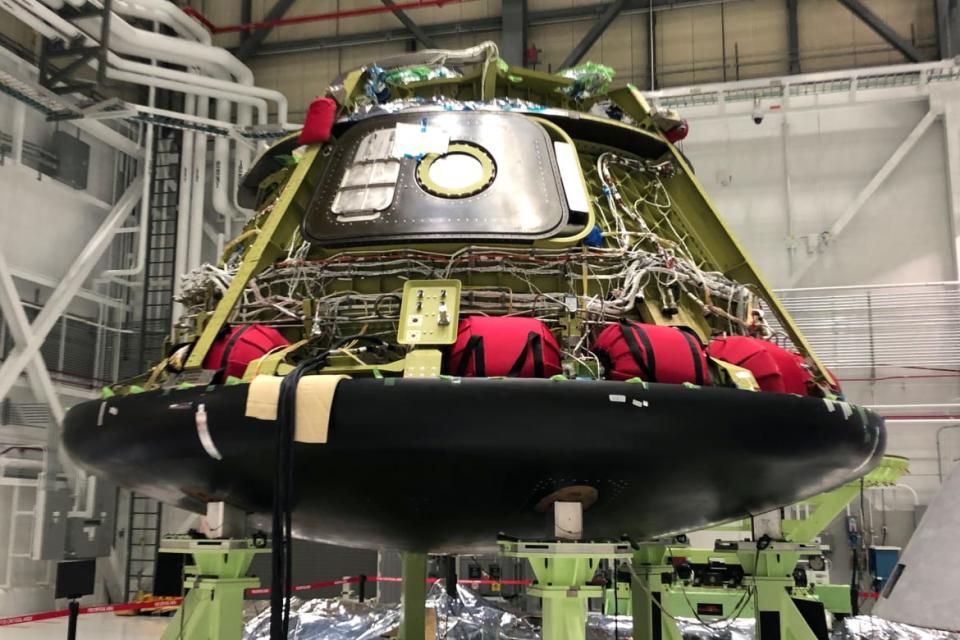
One of Boeing's CST-100 Starliner astronaut capsules at a production facility in 2019.
In 2019, the first unmanned test flight of their Starliner capsule, a project competing with Elon Musk’s SpaceX Dragon capsules for delivering astronauts and cargo to the International Space Station, was aborted because of a serious glitch in software that investigators said would have endangered the crew during re-entry to the Earth’s atmosphere. The program was again set back later this year when a launch was abandoned. This time, the problem was corroded valves, not software, a flaw that so dismayed NASA that they switched astronauts due to fly the Starliner to future SpaceX flights, reinforcing Musk’s dominance of the technology and deeply embarrassing Boeing. (Muilenburg had boasted that America would send humans to Mars on a Boeing rocket within a decade). A software glitch also compromised the flight controls of Boeing’s T-7 advanced jet trainer for the Air Force, a $9.2 billion program. This was added to the Air Force’s prolonged travails with a replacement for its aging fleet of inflight refueling tankers, the Boeing KC-46, which should have been a straightforward conversion of a commercial jet, the 767, but has become a textbook case of a seriously mishandled Pentagon contract, making a mockery of the promised budget and deadlines: due to be in full production by 2017, it will not now reach that point until 2024, costing Boeing at least $551 million of its own money to fix. The FAA has also been investigating continuing quality control failures on the production line of the 787 Dreamliner in Charleston, South Carolina.
TOO BIG TO HANDLE?
Failures on this scale across so wide a swathe of programs seriously undermine confidence in Boeing’s grip on its businesses, particularly with its three most vital customers, the Pentagon, the airlines, and NASA. In fact, the sheer technical diversity of the company and the different nature of the markets in which it competes suggests that it may be impossible for any chief executive to effectively master. The 1997 merger with McDonnell Douglas followed the classic General Electric industrial conglomerate model of combining several different businesses into a colossus under a single corporate management. As it happens, this month that original model at GE was finally abandoned. With GE’s performance under fire from investors, Larry Culp, the current chief executive, announced that the conglomerate would be broken up into three separate companies—health care, energy, and aviation. The logical equivalent for Boeing would be to split into defense, commercial aviation, and aerospace.
Whether or not that happens, one thing is certain: Before the merger with McDonnell Douglas, it would have been unthinkable that Boeing’s engineering quality could plunge as far as it has. Had failures on this scale occurred, heads would have rolled. The moonshot gambles that the Welch progeny so openly disavowed were, for sure, not what today’s investors would welcome—the most spectacular of them, the development of the 747, came close to bankrupting the company. But the payoff was immense and the stature of the company was unmatched. And Condit, for all his apparent carelessness with the company culture, had honor enough to fall on his sword for a breach of integrity by others. Not so Calhoun.
When Calhoun joined the Boeing board in 2009 he was already established as one of the super performers at the largest private equity firm, Blackstone. His business ethic had been shaped by 28 years of applying the Welch doctrine at GE (according to Robison, Welch’s speechwriter said of Calhoun, “He’s the guy who was really the most like Jack”) followed by vigorously practicing the very similar doctrine of private equity. Of course, private equity isn’t necessarily malign. Its vices and virtues have been argued for as long as it has been around, about 50 years. At its most positive it has transformed moribund businesses and created new ones. It’s also made many people very rich. But, in the wrong hands, it guts companies, not simply by stripping them of assets but stripping them of profits that should have been reinvested to sustain development. Calhoun represents a particularly aggressive strain of carnivorous capitalism. He’s aggressively anti-union and anti-regulation, and at Boeing he is unrepentant in his zeal to slash and burn. During the course of this year, the workforce will have been cut by 20 percent. Plants have been shuttered, buildings sold off.
After listing the costs to Boeing of the 737MAX catastrophe—direct costs of $21 billion, the loss of orders for the jet amounting to $128 billion— Robison writes in his new book:
“Yet the people who made the most damaging decisions, and laid on the impossible demands, kept rising to the top. Like Jack Welch’s General Electric before it, Boeing became a collection of assets to be shuffled as managers saw fit to make the most beneficial combination for stockholders, not for customers or employees.”
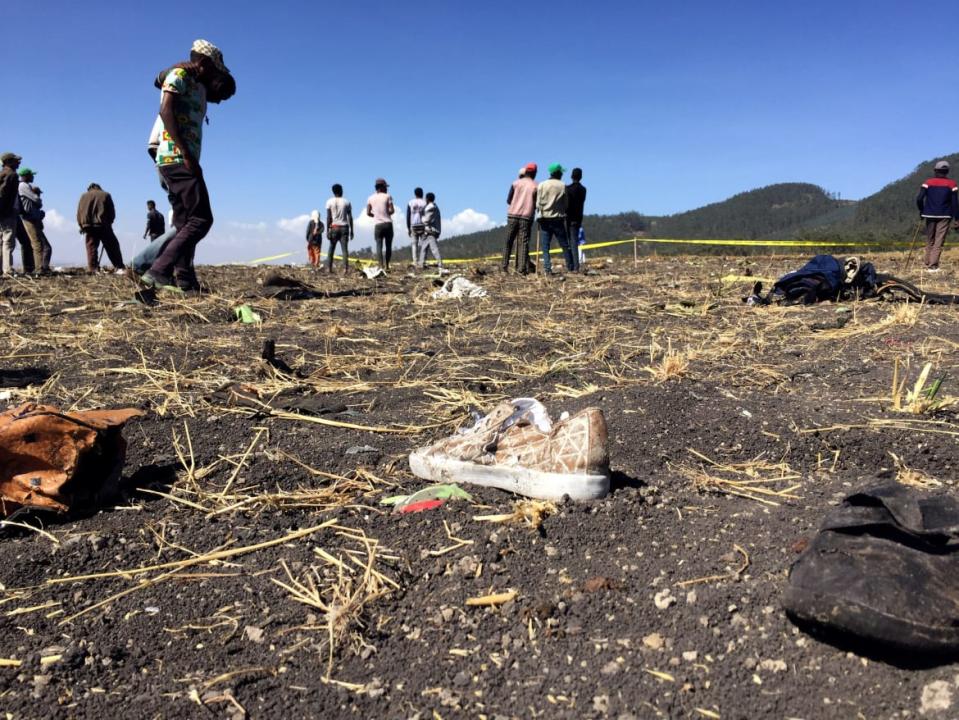
People walk at the scene of the Ethiopian Airlines Flight 302 plane crash southeast of Addis Ababa in 2019.
Some of the most powerful passages in Robison’s book are about the excruciating suffering of the families of those who died in the two crashes. He reminds us that these were extremely violent and gruesome deaths for the passengers and the crews, who remained fully conscious as the jets began high-speed death dives with the pilots unable to recover control: the Lion Air jet was ripped to pieces as it hit the sea and the Ethiopian jet scorched a deep crater in the desert, atomizing the victims.
HOW DO THEY SLEEP AT NIGHT?
None of the company’s top executives have been held accountable. In January, Boeing reached a deferred prosecution agreement with the Justice Department. Shifting the blame to lower managers, they admitted that regulators had been misled about the seriousness of changes made to the control system of the 737MAX. They agreed to pay $2.5 billion in fines and compensation to airlines and to the families of victims of the two crashes. That meant that the company itself escaped a criminal conviction that would have led to it being no longer able to bid for federal contracts—including as a defense contractor. This month a lawsuit brought by shareholders alleging negligence by members of the board was settled when the directors’ insurers agreed to pay $237.5 million to Boeing, although the directors denied any wrongdoing and, bizarrely, some of that payment actually flows back to the directors as well as the stockholders who brought the suit. That did not, however, shield individual managers from being charged and, last month, Mark Forkner, who had been the chief technical pilot on the 737MAX program, was indicted on charges that he deceived the regulators. Investigators for the House committee discovered that when other engineers told Forkner that airline pilots would need new training on simulators to adapt to the changes in the control system (the system that led to the crashes), he responded, “Boeing will not allow that to happen. We’ll go face to face with any regulator who tries to make that requirement.”
Robison follows Forkner’s role closely, including a note that Forkner sent to another test pilot boasting that he had been “Jedi-mind tricking regulators into accepting the training that I had got accepted by FAA etc.” Later, though, he admitted to being alarmed that the new automated control system could be triggered as soon as a few minutes after takeoff (which is what occurred in both fatal crashes). That did not, however, prevent Forkner from following the company line when Lion Air, receiving its first 737MAX jets, asked Boeing for simulator training for its pilots who were transitioning from the earlier model. Robison reports that Forkner’s response was to call the airline “idiots” and that, after a few conference calls, he had persuaded them that training wasn’t necessary and wrote to a colleague, “I save this company a sick amount of $$$$.”
Forkner’s defense lawyer told reporters, outside the court in Fort Worth, Texas, that Forkner was being used as a scapegoat: “The truth will show that Mark did not cause this tragedy, he did not lie, and he should not be charged.” Given all the evidence that Muilenburg had applied relentless pressure on the program’s managers to present an airplane to airlines that was little different than the previous model when, in fact, it introduced a critical and, as it turned out, fatally flawed system, Forkner appears to have been more a loyal messenger than a felon. Calhoun has claimed that Forkner was part of a “micro-culture” that did not represent Boeing, but if the case goes to trial, it’s likely that Muilenburg and Calhoun will be deposed, exposing them to discomforting questions about how such a “micro-culture” could have agency on their watch and about their own roles.
Boeing is no longer an industry lodestar. The company has not launched a new jet since the 787 Dreamliner in 2004. Without the incentive of that kind of innovation, the best engineers go elsewhere. The industry is now under great pressure to go green by cutting emissions and noise pollution. Electric power and cleaner fuels like hydrogen are the way ahead. Airbus has a very ambitious program to transform its airplanes. Boeing’s effort is, in its own words, limited to “sustainability rather than step-change, breakthrough innovations.” Indeed, it is still dependent on the 737MAX for the majority of its profits. Despite lost orders and the stigma of the crashes, there are still 3,000 of the jets on order by airlines because it is being sold at a heavy discount. That means that, given the normal lifespan of a jet, it could still be rolling up to airport gates in 2040, although by then it will resemble a relic of another age.
Get our top stories in your inbox every day. Sign up now!
Daily Beast Membership: Beast Inside goes deeper on the stories that matter to you. Learn more.

